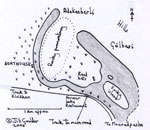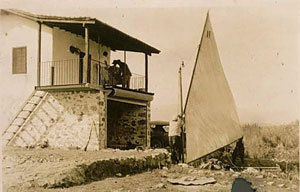
The boathouse in the 1930s from the SE, with Beetle II
(Susie Villard [Altounyan])
It began in 1994, when Taqui Altounyan talked to me about the little sailing dinghy called Peter Duck, that Ransome brought out for the Altounyans - the originals of the Swallows - when he visited them in Aleppo in 1932. AR spent weekends on his visit sailing with them, in Peter Duck and the Altounyans' own Beetle II, on a lake near Aleppo, in a region that later became part of Turkey.
AR was writing the book Peter Duck during his visit, and the contrast between his imaginary setting (Lowestoft and the West Indies) and his real one (urban Aleppo and a lake in a great plain) must have struck him. In Chapter I, written days after his arrival at the Mediterranean port of Alexandretta with the little dinghy in a box, we have the Swallows meeting Capt. Flint by the Customs shed and 'the little sailing boat that Captain Flint had brought in a crate all the way to Lowestoft from that far-away lake in the north'. On 5 February AR's diary reads 'Chapter II. 8 pp'. In the pages of PD that day he wrote
'"Are you all right?" called Captain Flint, when John and Nancy had stepped the mast and everybody was aboard. "Quite all right," said John, though he was feeling a little nervous at sailing Swallow in strange waters and for the first time for nearly a year.'
On 7 February, in the diary,
'Launched dinghy at Mourad Pasha, and sailed it (reefed, and then full but hideously setting sail) to the boathouse.'
As Swallow sees new lands and Peter Duck the old salt sets off on his last voyage, Peter Duck the dinghy sets off on her first.
The Swallows' lake
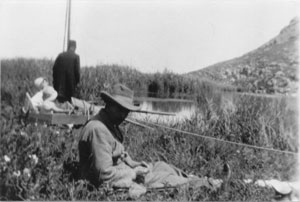
Ernest and family by the boathouse in the 1930s
(Taqui Altounyan)
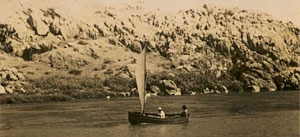
Peter Duck in 1932, taken from the boathouse
looking E (Susie Villard [Altounyan])
The Ransomes stayed in Syria for 2 ½ months. The Altounyans, in those happy pre-war days, had a summer house at Sogukoluk in the cool mountains between Aleppo and Alexandretta, a mill at Kirikhan at the foot of the mountains and a farm near there in the great plain of Antioch. The farm's land stretched to a little curving lake that wriggled through the reedy marshes to join the great shallow lake that then occupied much of the plain. Ernest Altounyan had discovered the little lake in 1929:
'We have just come back from a day on the most lovely inland sailing grounds imaginable. We went in canoes poled by ruffians. ...Miles and miles of it like the broadest broad until you get to the lake of Antioch'.
The lake was 90 minutes by car from Aleppo. Ernest had built a two-storey stone boathouse and acquired Beetle II, a 14-footer that leaked persistently. Now, with Ransome, came a little boat that his children could sail alone. Weekends were spent at the lake, fishing, sailing and riding. Both he and Ernest comment on the lake seeming like the Broads surrounded by Lake District mountains, and the letters to AR from the children after his return to England read like unpublished Swallows' despatches - Titty getting tangled in the reeds when the wind changed, Taqui being 'Captain Nancyish' with some lubberly visitors, Roger detailed to work a new 'engine' up at Sogukoluk.
A TARS expedition
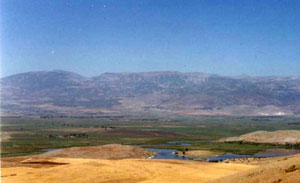
Looking W towards the lake and the Amanus mountains
(Alan Hakim 1994); the boathouse is behind the left-hand
end of the rocky promontory on the right
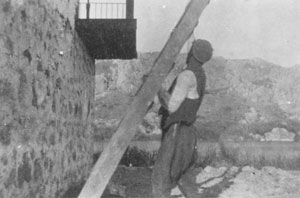
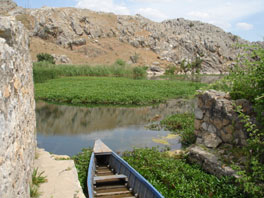
1) Hassan and the boathouse balcony in the 1930s (Taqui Altounyan)
2) Inside the boathouse, looking NE, with Ali's boat (JG 2006). The rocks on the promontory opposite exactly match those in the 1930s photo of Hassan and the boathouse

The Altounyan boathouse from the water in 2006,
looking SW (JG)
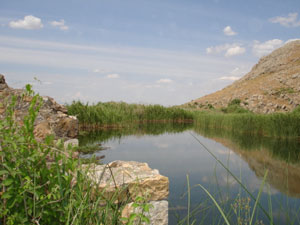
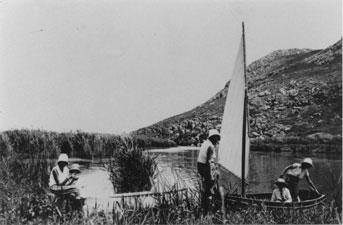
1) Looking north from the boathouse to the rocky promontory in 2006 (JG)
2) The same view in 1932 (Brotherton Library): The photo in Christina Hardyment's book, showing Susie, (Dora?), Taqui, Roger, Titty with Peter Duck
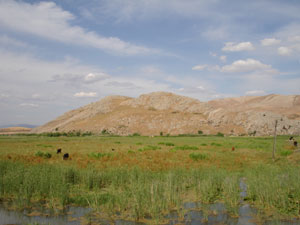
The boathouse (in centre) from the S, just below,
and dwarfed by, the rocky promontory (JG 2006).
This land was the Altounyans' farm
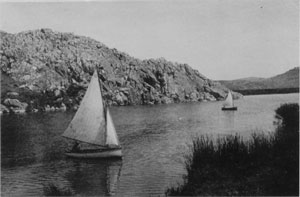

1) Looking east from the boathouse in 1932 (Brotherton Library), the year of AR's visit; Beetle II (left) and Peter Duck;
2) The same view in 2006 (JG)

The boathouse from the north, amid the marshes
(JG 2006)

'Canoes poled by ruffians' (Ernest 1929 in a letter to AR):
Marsh Arabs still live in reed huts by the lake
(JG 1994)
Taqui's memories prompted me to seek out the little lake where she sailed with AR. I trawled the Brotherton library's Ransome documents in Leeds, narrowing the location down to a village called Adakanberli in the northern Amuk plain in the Hatay of Turkey, near Muratpasa on the Aleppo road. In September 1994 I recruited Alan Hakim as a travelling companion and we headed for Turkey. Our quest was much helped by enthusiastic offerings of photos by the three Altounyans Susie, Brigit and Taqui: our expedition seemed to have struck a real chord with the Altounyan children, and it was as if, like Captain Flint and his crew, we were leaving Peter Duck with his memories in the schooner at anchor while we went forth to dig for his 60-year-old treasure.
The great lake of Antioch is now dry and planted with cotton, and the bridge where Brigit fished with AR stands lonely amid a field: this was Peter Duck's launching place. But to our delight the little blue, reedy C-shaped extension to the lake, where AR and the children sailed, is still there, though taking determined searching and much studying of maps to find.
Alan and I explored the lake as far as we could, and brought back photos and tales of the place where AR had sailed with his Swallows; but we found no trace of the two-storey boathouse described by Ernest Altounyan as the base for their sailing weekends away from their home in Aleppo:
(Ernest in a 1930 letter to AR, urging him to visit) 'We can put you and Genia up quite cosily and when we get tired of you we shall give you the room over the boat house nicely grilled off for mosquitoes with balcony from which you can get an uninterrupted view of my red and white can buoy. You pull up the ladder after you at night...'.
Here was where Peter Duck, the little dinghy brought from England by AR in 1932, lived, along with the Altounyans' leaky Beetle II. There was a part of the lake that we hadn't been able to reach - a marshy stretch running south from Adakanberli in the north-west - and surely the boathouse might be found there?
Then in 2006 archaeological business took me to southern Turkey, and my chance came to finish the search. The trackless marshes stretch in all directions, punctuated by islands of rocky ground; natives are friendly, but scarce and non-English-speaking. The best bet seemed to be to get to Adakanberli, on the far side of the little lake, and hope to spot the remains of the boathouse from the rocky promontory stretching south from there.
By extraordinary good luck, a fisherman saw me on the promontory and gave me a lift in his boat. He started to talk in gestures about an old structure linked with boats, round the corner to the south, and I gratefully allowed him to show me.
And THERE IT WAS - ruined, but unmistakably the boathouse in the 1930s photos that I had in my hands. There was the same rock-face opposite the building, every rock identifiable, and there was the exact view shown in the 1930s photo from Christina Hardyment's book 'Arthur Ransome and Captain Flint's Trunk'.
The building is no longer two-storey, and the hard standing around it has crumbled away; nothing remains of the structure behind the boathouse itself, seen in an old photo (see top of article) sent to us in 1994 by Susie Altounyan.
But this was the place to which AR and the Altounyans sailed Peter Duck on her maiden voyage in 1932. AR is cursory about it in his diary, but Taqui Altounyan describes the moment in In Aleppo Once:
'One Sunday we launched her at the farm into the blue water and the water-lilies. The varnished planks glittered in the sunshine, and the creamy sails flapped out for the first time, and the silky shining ropes took their first strain. The little walnut shell built at Pin Mill in Essex threaded its way through exotic eastern waters, avoiding submerged buffaloes, racing with piratical-looking Arab boys poling their kayaks.'
It was from this little building that AR and his 'real Swallows' set off on their weekend voyages in Peter Duck, and it was here that he sat and smoked with Ernest and planned further pages of Peter Duck the book, which he was writing during his stay with the Altounyans.
Ernest, in a 1929 letter to AR, announcing his discovery of 'the most lovely inland sailing grounds imaginable', enthuses that 'The Broads actually begin on our land and I have only just realised it.' Brigit Altounyan had told me in 1994 that their land ran from the farm to the road and that they rode from the farm to the boathouse: here was their farmland, where cattle still browse with wet feet, and the place of which AR wrote in his diary 'Rode!!! across the marshes.'
AR was not the only writer to visit the boathouse: Freya Stark, in 'Dust in the Lion's Paw', describes visiting in 1939 the Altounyans'
'model dairy farm and boathouse on the lake of Antioch.... I can't tell you how lovely that plain is - water avenues of yellow iris and white flowers: a strange cold colour like shot silk'.
But political destiny was about to overtake this enchanting, forgotten area: Freya Stark adds,
'everyone wonders whether this province will be given to the Turks and when. Already their flags flutter everywhere... - all may go from one moment to the next.'
The four eldest children had only had the summer of 1932 in which to sail Peter Duck before the shades of school in England descended. Only Brigit was left to sail with her father, and though the other children did return at times, in 1939 a grimmer shadow than school fell. Not only the war in Europe: in Syria the French carried out their long-threatened action of handing the Sanjak of Alexandretta - the port and its hinterland, containing Sogukoluk and the lake - over to the Turks.


